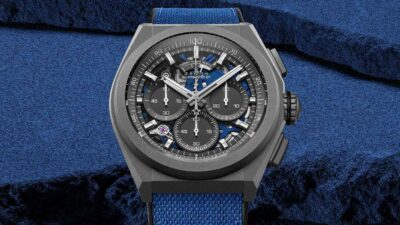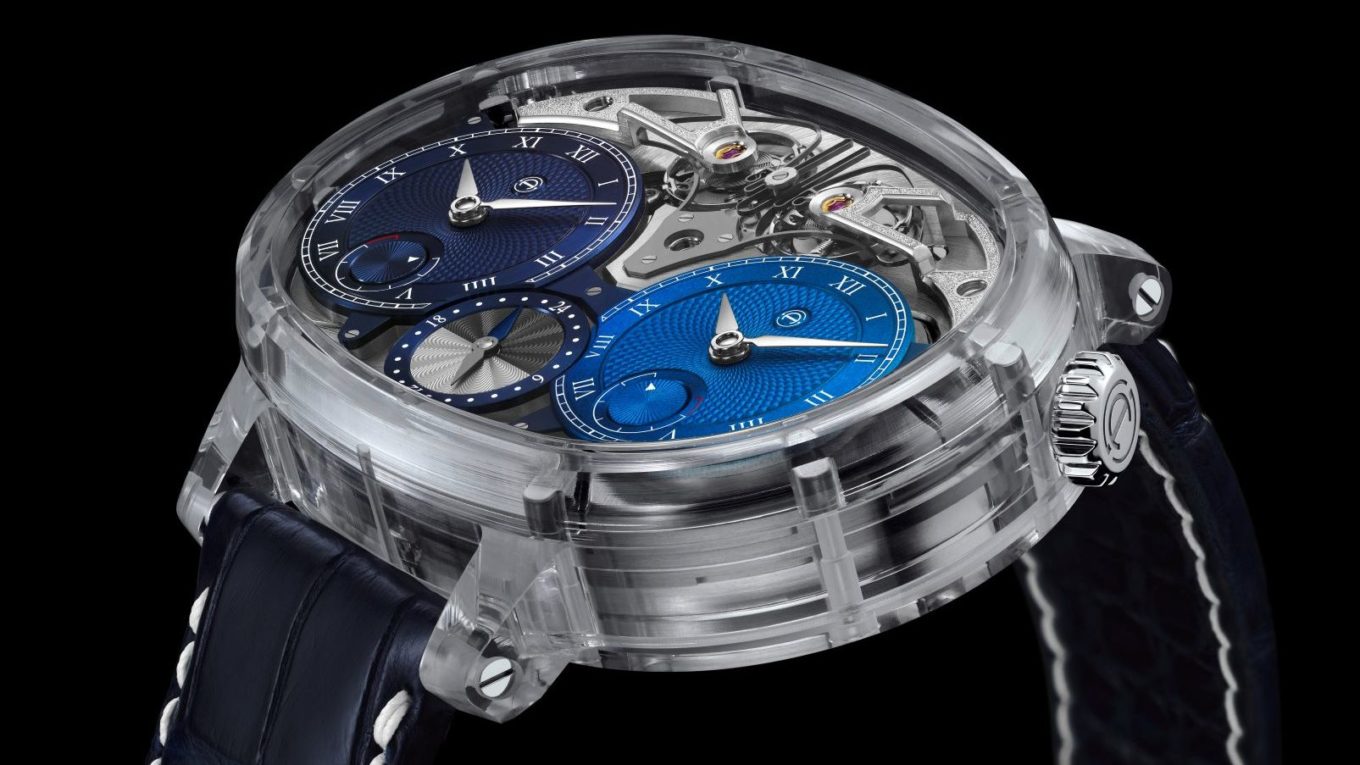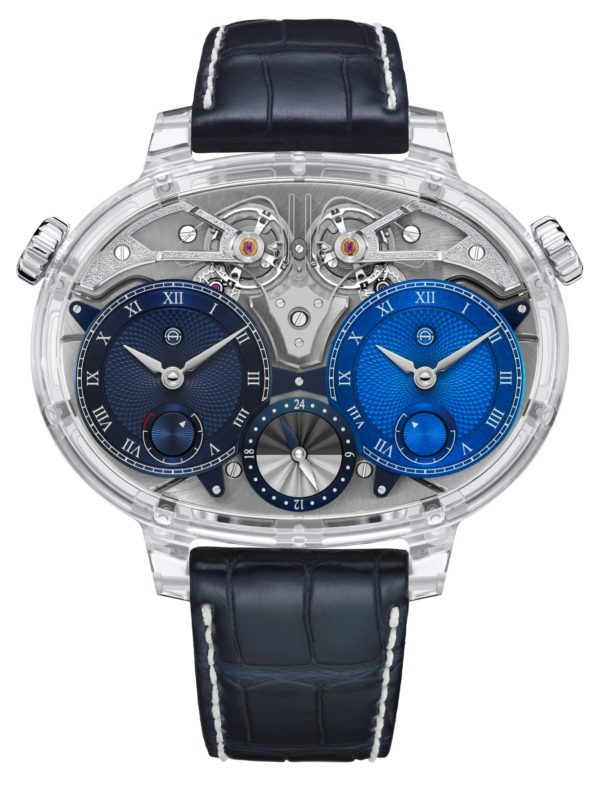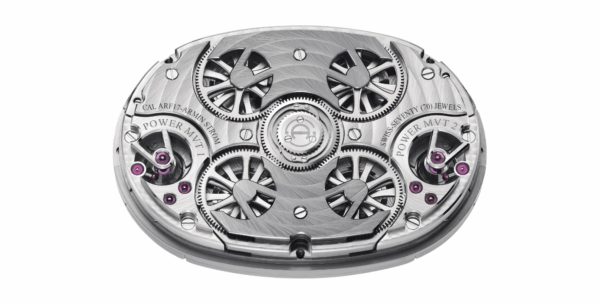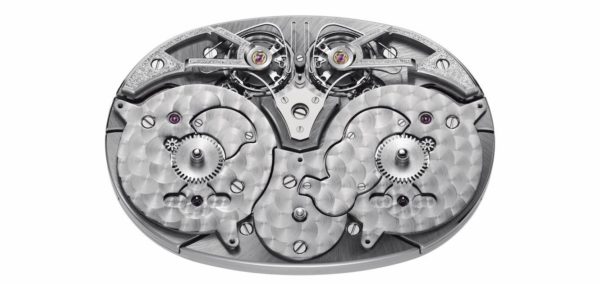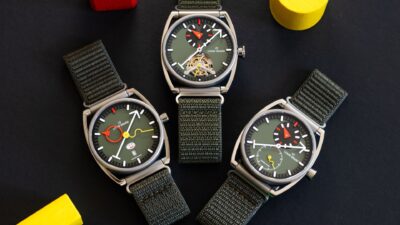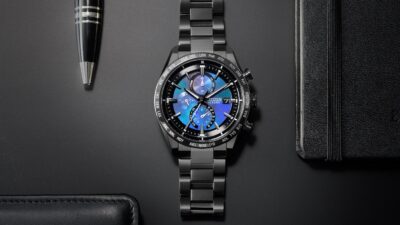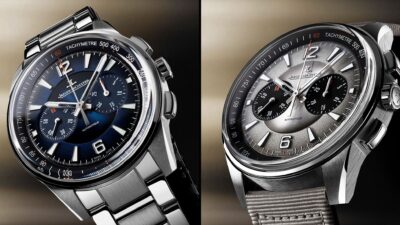Wearing the Dual Time Resonance Sapphire is like wearing a movement on the wrist, with all of Armin Strom’s meticulous hand finishing and inventive horology on full display.
“This new Sapphire case sets the perfect stage for the detailed work and passion we put into the Dual Time Resonance. The total transparency does not allow for any mistakes and demands a finish on the highest level, which goes in line with our philosophy,” says Claude Greisler, co-founder of the manufacture.
Armin Strom began research and development into using the phenomenon of resonance in a wristwatch with two main goals: the first that any resonant complication should demonstrably improve timekeeping precision, and the second that people should be able to visually appreciate the phenomenon of resonance as it happens.
Independent movements enable the Dual Time Resonance Sapphire to indicate GMT, a second time zone, or function as a timer or countdown. Completing the indications are independent power reserve indicators and a 24-hour indication serving both displays. The CSEM (Centre Suisse d’Electronique et de Microtechnique) has officially certified Armin Strom’s Resonance Clutch Spring system as being a true system in resonance. Armin Strom’s laboratory testing has revealed gains in precision of 15-20% for two COSC-certified chronometer-level regulated movements placed in resonance.
The Armin Strom Masterpiece 1 Dual Time Resonance Sapphire launches in a scratch-resistant limited edition of 8 pieces.
Dual Time Resonance Sapphire: crystal-clear evolution
With the introduction of the Mirrored Force Resonance, Armin Strom revolutionized both the practical and aesthetical benefits of using the physical properties of resonance in wristwatches. The Mirrored Force Resonance demystified resonance by placing two oscillators resonating through the patented Resonant Clutch Spring front and center. Here, the dials and dual regulators sit on top of two vertically-stacked, independent movements.
To highlight the highest level of horology and micro-engineering, Dual Time Resonance highlights the duality of the two independent resonating movements by replacing the vertical ‘stacked’ movement architecture with horizontal side-by-side movements. This has the added attraction of enabling appreciation of even more of the impeccably finished movement.
Armin Strom technical director Claude Greisler explains, “Developing a perpetual calendar or tourbillon would have been far easier than the years we spent calculating and validating the Resonance Clutch Spring; it was uncharted territory.”
Dual Time Resonance Sapphire now removes any and all barriers to appreciation: the case ‘disappears’ in an unabashed celebration of the reliably resonating calibre ARF17 movement seemingly floating between strap ends. The transparent case of Dual Time Resonance largely disappears from view, which amplifies the form-follows-function horizontal movement architecture of the caliber ARF17.
“The transparency of the case goes in line with the work we are doing in the Switzerland-based manufacture. We show what we make ourselves and we are driven by perfection” says Armin Strom founder Serge Michel. “There is a lot of work done by hand and we wanted to have the possibility to show the 360° decoration on every piece from Armin Strom and this one in particular.”
Dual Time Resonance Sapphire: sapphire crystal
The attraction of sapphire crystal watch cases is (transparently) obvious; the difficulty, though, in cutting, milling, polishing, and assembling sapphire crystal case components is extreme, especially in relatively large — in this case 59 mm long — case components. Sapphire crystal rates 9.0 on the Mohs scale, as opposed to 9.5 for moissanite and 10 for diamond. Diamond-coated tools spend days cutting, then milling the case components from massive sapphire crystal blocks. These are then left for a few days to allow any tension generated by the heat of machining to be evenly distributed throughout the crystal. The case is then polished for days, transforming the opaque milled crystal into one that is crystal clear. Sapphire crystal’s main challenge is its extreme hardness. Like the less glamorous but equally contemporary ceramic cases, hardness is the cause of susceptibility to chipping, cracking, or shattering: sapphire crystal is fragile, and this creates a manufacturing process that is very long,and very complicated with a lot of breakage.
Dual Time Resonance: inspiration and development
Masterpiece 1 Dual Time Resonance was developed as a showcase for Armin Strom’s technical and artistic excellence, bringing the phenomenon of resonance front and centre. The Resonance Clutch Spring allows the mysterious force of resonance to be visualized in real time. It’s a visually entertaining complication as well as a technical tour de force, a performance-enhancing mechanism so obvious that you can see it. While it has been long known that resonance in watch and clock movements with synchronized coupled oscillators improves accuracy by averaging slight differences in the precision of each movement – and in wristwatches minimises adverse effects of shocks on precision – it is less known that resonance also conserves vibrational energy normally lost through supporting the regulator.
Armin Strom’s laboratory testing has revealed gains in precision of 15-20% for two COSC-certified chronometer-level regulated movements placed in resonance. But the manufacture did not set out to make a dual time watch; the principal aim was to showcase the resonance movement to the maximum. The movement architecture was a perfect meld of form and function: spreading the two movements apart horizontally in the Dual Time Resonance – compared to the two vertically stacked movements of the Armin Strom Mirrored Force Resonance – meant that a dial on each movement was a logical choice. And with two time displays, dual time follows naturally. The independent second time display can also function as a countdown indicator or for tracking elapsed time. Two independent movements mean two independent time displays, one 24-hour indicator, four mainspring barrels, and two conical power reserve indicators.
In the pursuit of horological accuracy, precision, and rate stability, resonance has usually involved using two connected independent movements to allow fine tuning of the distance between them. Until Armin Strom, precise adjustment of the distance between the two regulators has been necessary to incite resonance. However, the Armin Strom Resonance Clutch Spring eliminates the necessity for fine tuning the distance, ensuring a much more reliable and efficient resonant system only needing up to 10 minutes to synchronise. The idea of resonance has endured for three centuries for a reason, but that doesn’t mean you can’t improve upon it. Armin Strom’s patented Resonance Clutch Spring is an innovative way of upgrading an old concept, one that is horology’s very reason for being: precision and accuracy. The CSEM (Centre Suisse d’Electronique et de Microtechnique) has officially certified Armin Strom’s resonance system based on the Resonance Clutch Spring as being a true system in resonance.
What is resonance?
Any body in motion causes vibrations in its surroundings. When another body with a similar natural resonant frequency to the first receives these vibrations, it absorbs energy from it and starts vibrating at the same frequency in a sympathetic manner. For example, a trained singer can hold a note causing a tuning fork tuned to the same frequency to vibrate. For the oscillators of a watch movement to be able to synchronize with each other, they have to be closely tuned. Imagine a small child trying to synchronize steps with an adult: he or she is unlikely to synchronise for more than a few steps as the systems are too dissimilar to resonate. Or imagine yourself pushing a child on a swing: the child and the swing make a natural pendulum, which will have an inherent natural frequency (speed of swing back and forth). If you push at the wrong frequency (too fast or too slow) then you are likely to block the motion and slow the swing down; however, if you push at or near the natural frequency of the swing then you will increase the amplitude (distance the swing moves) of the child/swing system.
In horology, the phenomenon of synchronized motion has fascinated watchmakers since the time of Christiaan Huygens (1629-1695). Huygens, inventor of the pendulum clock, was the first to discover the resonance of two separate pendulum clocks, which he logically surmised should keep slightly different time. When hung from a common beam, however, the pendulums of the adjacent clocks synchronized; subsequent researchers confirmed that the common wooden beam coupled the vibrations and created resonance. The two pendulums functioned as one in a synchronous manner. In the eighteenth century, Abraham-Louis Breguet demonstrated his mastery of the physics with a double pendulum resonance clock. An outside shock slowing down one of them increases the speed of the other one by the same amount; but both will strive to get back in resonance, averaging and minimizing the effects of the outside influence as they find their rhythm. What was true for Huygens’ and Breguet’s clocks is just as true for Armin Strom’s wristwatch. The advantages of resonance are threefold: 1) stabilizing effect on timekeeping, meaning better accuracy; 2) conservation of energy (think of a professional cyclist riding in the shadow of another cyclist in a racing situation); and 3) reduction of negative effects on timekeeping accuracy due to outside perturbation such as shock to the balance staff, which in turn keeps the rate stabler (better accuracy). While the advantages of resonance have been known for centuries, only a handful of clockmakers and watchmakers have created timepieces deliberately and successfully exploiting the phenomenon of resonance, including Antide Janvier (1751-1855) and Abraham-Louis Breguet (1747-1823).
And, now, Armin Strom.
Dual Time Resonance Sapphire
Reference number: RGMT.11.AL.L.14.FC
Indications:
Movement 1: hours, minutes, 24-hour indicator, power reserve indicator;
Movement 2: hours, minutes, power reserve indicator
Movement: Armin Strom manufacture calibre ARF17
Manual-winding, patented resonance clutch spring, dual off-centre time indications, 4 mainspring barrels
Regulating system: two independent regulation systems connected by a resonance clutch spring
Power reserves: conical x 2, 110 hours for each movement
Dimensions: 52.55 mm x 39.95 mm x 11.67 mm
Frequency: 3.5 Hz (25,200 vph)
Finishing: base plate and bridges are decorated to the highest quality level
Jewels: 70
Number of components: 419
Case: Sapphire crystal
Sapphire crystal front and case back with antireflective treatment
Diameter: 59 mm x 43.4 mm (including lugs)
Height: 13 mm
Water resistance: 50m
Dials: blue, hand guilloche
Hands: polished stainless steel
Straps: delivered with a blue alligator strap and stainless steel double-folding clasp.
Price: CHF 280,000.-
